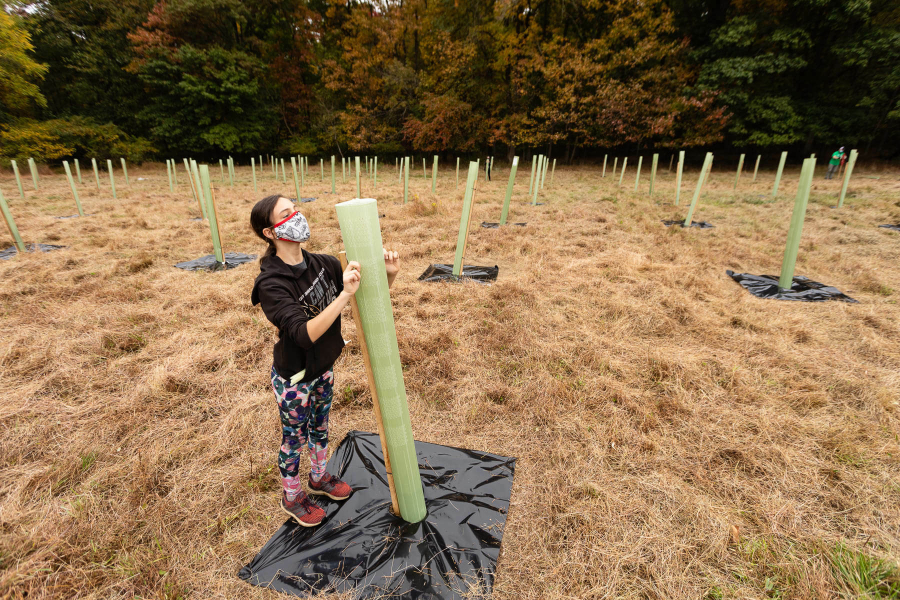How the Chesapeake region can slow down—and adapt to—climate change

Though not everyone sees it in their day-to-day lives, climate change has already made a big impact on the Chesapeake Bay watershed.
Whether it’s increased flooding in communities, warmer waters threatening marine life or droughts making farming more difficult, the effects are widespread and here to stay.
When it comes to combating these changes, there are two approaches that groups like the Chesapeake Bay Program take: climate change mitigation and climate change adaptation. Mitigation and adaptation efforts are both important to how our communities, states and region will tackle climate change.
Climate change mitigation is the things we do to try to reduce, stop or reverse climate change. It refers to reducing the concentration of greenhouse gases, such as carbon dioxide, in the atmosphere by either limiting or eliminating emission sources or enhancing activities that remove, trap and store gasses.
Climate change adaptation is the things we do to deal with the effects of climate change. It refers to the actions we take to better withstand the resulting impacts of a changing climate, such as increased flooding, warming waters and severe weather.
How is climate change affecting the Bay?
Climate change refers to how the environment is reacting to extensive carbon dioxide emissions that humans release into the atmosphere through the exhaust from cars, factories, heating units and various other gas-powered machines.
These emissions have led to an increase in global temperatures that disrupt ecosystems and cause the polar ice caps to melt. Because the ice caps are melting, more water is flowing into the ocean and raising sea levels. Higher temperatures also increase evaporation, which ultimately leads to more severe storms.
All this has caused trouble for Chesapeake residents and wildlife. Rising water levels are causing communities to flood and beaches, shorelines and islands to erode. Higher average temperatures means warmer water, which threatens marine life and in some cases, removes oxygen from the water. More severe weather can damage crops, erode soil, increase flooding and in the case of rainstorms, wash more chemicals and nutrient pollutants into the Bay.
Tackling all these threats is a big job. In the Chesapeake watershed, our work can both help communities and the ecosystem in the short term as well as slow down climate change in the long term.
Mitigation vs. adaptation
Climate change mitigation
The Chesapeake Bay Program is working to mitigate the effects of climate change. Throughout the Chesapeake Bay watershed, our wetlands, forests and underwater grasses all act as “carbon sinks” that remove, trap and store carbon-related emissions. The Bay Program has workgroups dedicated to restoring and protecting each one of these natural spaces. Additionally, the Climate Resiliency Workgroup helps identify the science and policy needed to allow tidal wetland conservation and restoration efforts to be incorporated into existing blue carbon crediting systems—a market-based approach that groups use as a way to offset carbon emissions. There are also various regulations and initiatives that our state and federal partners are using to reduce greenhouse gas emissions in the watershed. For example, they include improving gas mileage on vehicles, requiring new construction to be more energy-efficient and providing tax credits for solar panels. At the Bay Program, our Sustainable Schools outcome encourages public and private schools to reduce their emissions with actions like installing green roofs or using solar panels.
Climate change adaptation
We are also working to adapt to the effects of climate change. Our Climate Resiliency Workgroup leads a coordinated effort to pursue, design and construct projects that reduce the impact of issues like flooding, high temperatures and extreme weather. To reduce flooding and erosion, we help communities protect their shorelines and lead efforts to restore wetlands, oyster reefs and underwater grasses—all of which absorb wave energy. We support tree planting projects through our Forest Buffers outcome and Tree Canopy outcome, which helps reduce urban heat islands in cities or cool streams and rivers in rural areas. The Bay Program also provides funding and support for communities trying to manage flooding. This work includes both gray infrastructure, like sea walls that keep rivers from overflowing, as well as green infrastructure, like rain gardens, tree boxes and permeable pavers. Green infrastructure not only reduces flooding, but provides a range of other environmental benefits.
Keeping an eye on the future
Climate change is unprecedented. The scientific community is still learning how fast it will occur and the effects it will have. In addition to our Climate Adaptation outcome, which covers the projects mentioned above, we also have an outcome dedicated to monitoring current and future threats and assessing the effectiveness of our solutions.
Interested in helping to combat climate change? Consider reducing your carbon emissions by biking or walking instead of driving, reducing food waste or composting, and planting trees and exploring ways to offset your carbon footprint.

Comments
There are no comments.
Thank you!
Your comment has been received. Before it can be published, the comment will be reviewed by our team to ensure it adheres with our rules of engagement.
Back to recent stories